Heat Meets East: A Guide to Asian Hot Sauces
If you’ve never tried Asian hot sauce, you’re missing out on a whole new world of heat and flavor. These spicy Eastern condiments come in a variety of forms, each offering a unique taste and pungency.
Asian hot sauces are a group of hot condiments or seasonings originating from Asian countries such as Korea, China, Thailand, Japan, and Vietnam. These sauces are typically made from traditional recipes that have been passed down for generations. The majority contain chili peppers, with textures varying from oily liquids like China’s chili sauce to heavy pastes like Korea’s gochujang. Their colors range from the fiery red of Thailand’s sriracha to the mellow green of Japan’s wasabi.
These hot sauces are a must-have in any Asian household. Thanks to the love of heat in Asian cuisine, hot sauces are thrown on any kind of meal. In the last few decades, the condiments have made their way to countries outside the continent, particularly the United States.
Join us as we embark on a spicy culinary journey through Asia to find and review the best hot sauces. Let’s start from the very beginning and make our way to a deep dive into the most popular Asian hot sauces of 2024, including details of how you can use them to elevate your cooking.
The Origins of Asian Hot Sauce: A Cultural Staple
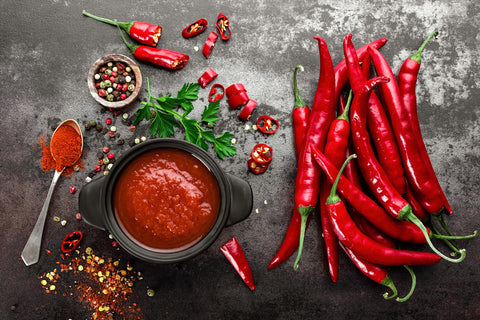
The first appearance of chili peppers in Asia was in 1542, when Portuguese missionaries brought some to the shores of Japan. These soon spread to Korea and then to other Asian countries. From 1543 to 1806, the Silk Road served as a trading network for a variety of foods and ingredients between China and other parts of the world. It was through this route that chili peppers, chili oil, and hot sauce spread through China and other parts of Asia.
In the early 1900s, Cantonese and Chinese immigrants could be found all over Asia, including Japan, Korea, and Thailand. They took with them recipes for their hot sauces, which served as an inspiration for the locals to make their own. The chili pepper and fresh garlic sauce of Cantonese immigrants from Shunde, China, served as the inspiration for Sriracha, Asia's most well-known hot sauce. Today, Sriracha and other fiery condiments have become integral to culinary traditions across the continent. There is hardly any existing traditional dish that doesn’t incorporate hot sauce in its preparation.
The Health Benefits of Asian Hot Sauces
Besides the perks they bring to the kitchen, hot sauces also possess several health benefits, which we’ll reveal below:
-
Metabolism Boost: Most Asian hot sauces contain an active component known as capsaicin. This component gives the sauce its pungency, but it also speeds up metabolism in the body.
-
Better Digestion: Fermentation is a common procedure when making some Asian sauces. Bacteria break down the food components in advance, making it easier for your body to digest the food.
-
Immune System Boost: Asian hot sauces tend to be rich in vitamins and minerals, including vitamin C, which helps boost your immune system.
-
Anti-Inflammatory Nature: Sauces that contain chili pepper have antioxidant properties, which help to lower blood pressure and reduce inflammation.
-
Pain Relief: Capsaicin also relieves pain, making it a great option for those managing migraines and joint pain.
Types of Asian Hot Sauces: From Mild to Wild
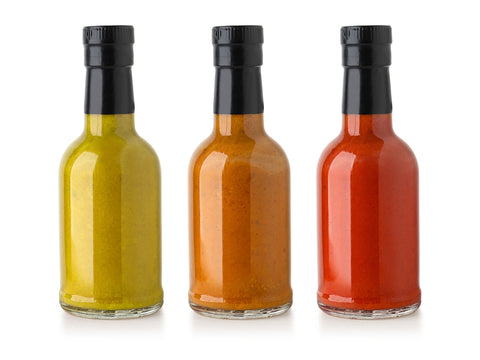
Asia currently boasts various types of Asian hot sauces, ranging from mild to hot. Below is a list of some of the most famous Asian hot sauces and their birthplaces:
-
Sriracha (Thailand)
-
Gochujang (South Korea)
-
Wasabi (Japan)
-
Sambal (Indonesia)
-
Sweet Chili Sauce (China)
-
Lao Gan Ma (China)
-
Nam Prik (Thailand)
-
Shichimi Togarashi (Japan)
In the next few sections, we’ll explore the very best of these sauces, beginning with the most popular one, Sriracha.
Sriracha: Thailand's Gift to Hot Sauce Lovers
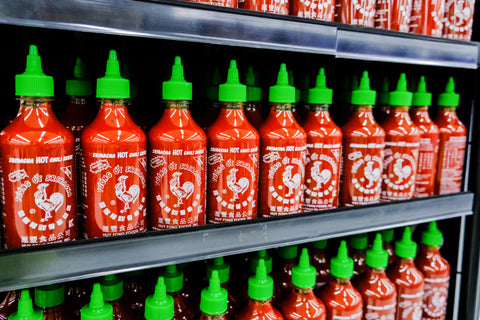
Sriracha is a Thai hot sauce made with chili peppers, garlic, distilled vinegar, sugar, and salt. It’s arguably the most famous Asian hot sauce in the world, thanks to Huy Fong Foods, the manufacturer of the most iconic version of the hot sauce. The iconic green cap and red bottle can be found all over the US and in other parts of the world. Besides being the most popular, sriracha also has one of the most unique origin stories of any hot sauce.
It was invented in 1949 by Ms. Thanom Chakkapak, a Thai woman living in Si Racha, Thailand. She commercialized the sauce as Sriraja Panich and it soon became a popular brand in Thailand and some parts of Asia. She sold it to Thai Theparos Food Products in 1984, and the Sriraja Panich brand exists today. So, how did Huy Fong Foods outsell the owners of the original sriracha brand?
David Tran, the Vietnamese founder of HFF, opened his business in Los Angeles and initially focused on selling to the Asian communities in the area. Their Sriracha hot sauce sold so well that other manufacturers sprung up with their own brands of sriracha, further driving the overall popularity of the Asian sauce.
Sriracha is incredibly flavorful for a hot sauce and its spice levels range from mild to mild-hot. It’s a perfect condiment, dip (especially mixed with soy sauce), topping, and ingredient for everyday dishes. Feel free to get your own bottle of the original Huy Fong Sriracha from Bokksu Market.
Gochujang: Korea's Fermented Chili Paste
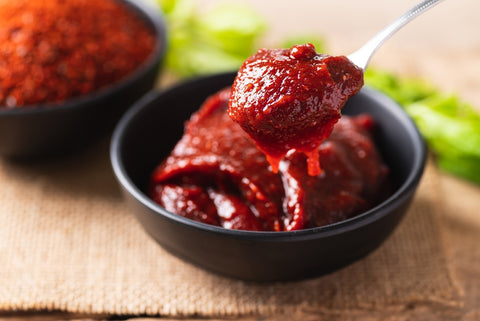
Gochujang is a Korean red chili pepper paste. It consists of fermented soybeans (meju), Korean chili powder (gochugaru), barley malt powder (yeotgireum), glutinous rice (chapssal), salt, and sugar. Additional ingredients you might find in this sauce include rice syrup (jocheong), rice wine (soju), and plum extract (maesilcheong). The presence of glutinous rice makes gochujang sweeter than most Asian hot sauces. It’s a delicious, thick, and pastey sauce with an elaborate traditional preparation method.
Gochujang is made by soaking barley malt in water and extracting the milky liquid it creates. This malted water is used to boil glutinous rice into a thick paste. The paste is then mixed with other ingredients, including pre-made gochugaru chili powder, fermented soybeans, salt, sugar, and sweeteners.
The final result is a tasty bowl of sweet, spicy, and tangy gochujang, which is used for a variety of Korean dishes such as kimchi, bibimbap, and tteokbokki. There are lots of brands selling their own versions of the hot pepper paste. However, we recommend Jonggavision Gochujang because of its authenticity and great mix of flavors.
Wasabi: Japan's Fiery Green Condiment

Wasabi sauce is made from a Japanese horseradish of the same name. It’s a unique and potent hot sauce alternative from Japan with a mild hot pungency.
Making wasabi sauce involves combining wasabi powder, mustard, and vinegar to create a hot, green paste. Traditionally, wasabi functions as a condiment and preservative for raw fish. It has the unique ability to unravel the taste of fish, which makes it a staple condiment for seafood. Today, wasabi sauce is commonly eaten with sushi and sashimi, where it kills dangerous bacteria and enhances flavors.
Besides having a green color, which is a sharp contrast to typical hot sauces, wasabi is different in other ways. The plant that it’s made from produces a chemical known as allyl isothiocyanate (AITC), which creates a unique type of spiciness that affects the nose and sinus more than it does the tongue. For your sashimi, sandwiches, and fries, we recommend the subtle heat of S&B Wasabi Sauce.
Sambal: Indonesia's Spicy Secret
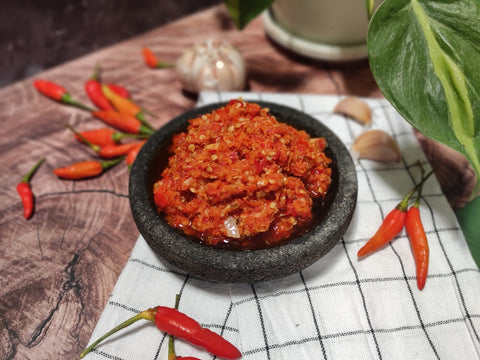
Originating in Indonesia, Sambal has one of the most diverse makeups among other hot sauces from Asia. You’ll find versions made with a variety of chili peppers and secondary ingredients. The different kinds of chili peppers used to make sambal include habanero, cayenne, bird's eye chili, and cabe taliwang. Some of the secondary ingredients are garlic, ginger, shrimp paste, scallion, lime juice, and palm sugar. Sambal is also popular in the Netherlands, Malaysia, and Singapore.
Indonesian sambal has over 212 variations, including sambal andaliman, sambal badjak, sambal oelek, and sambal asam. Sambal oelek, one of the most famous variants, is slightly hotter than sriracha but contains less vinegar. It’s also way less flavorful. Sambal, in general, has become a staple condiment and is used to add depth to Indonesian dishes like grilled fish (ikan bakar), fried chicken (ayam goreng), ribs (iga penyet), and soto soups.
Lao Gan Ma: The Iconic Chinese Chili Sauce

This hot sauce holds a unique spot in our list of Asian hot sauces because it’s a brand and not a type of hot sauce. Popular in China and 30 more countries, it’s easy to see why Lao Gan Ma or Old Godmother, deserves its own place among iconic Asian chili sauces. The sauce is famous for its original flavors from Guizhou, China, which are more complex than your average chili sauce. It tastes fantastic with BBQ, noodles, fish, meats, pasta, and more. The original La Gan Ma chili crisp combines chili pepper, fermented soybeans, onions, garlic, and other ingredients.
A woman by the name of Tao Huabi created LGM chili sauce in 1984. She opened a noodle restaurant in 1989 in Guiyang, a city in the Guizhou province of China. Huabi soon noticed that her original hot sauce was the restaurant’s most prized asset. Hence, she pivoted to business and turned it into a specialty shop for her Asian chili sauce.
Word of her special sauce got out and people from all over China began to patronize the brand. By 1994, Huabi had expanded her business by opening a new factory and hiring more workers. A few years later, Lao Gan Ma products can be found in specialty stores and supermarkets all over China, the United States, and other countries. You can also order Lao Gan Ma Crunchy Hot Chili Sauce from Bokksu Market.
Sweet Chili Sauce: Asia's Favorite Dip

You might come across brands that include the word “Thai” when naming their sweet chili sauce, but make no mistake, this condiment hails from China—Zhongshan City, to be exact. Trading and immigration brought it to Thailand, where its popularity extended to other nations. Today, sweet chili sauce is the most beloved dipping sauce in Asia, thanks to the balance of sweetness and heat that it brings to food.
Sweet chili sauce is made from chili pepper, rice wine vinegar, garlic, fish sauce, and a sweetener, which could be fruit, honey, or white or brown sugar. The sauce is tangy but sweet, with a subtle kick of heat. It makes a great dip for dumplings, spring rolls, and chicken wings. It also works well as a marinade for grilled chicken, seafood, and pork. Cooking the sauce will caramelize the sugars in it and cause it to add an extra sweet and hot depth to meals.
You should try Mae Ploy Sweet Chili Sauce if you’re looking for a versatile dip for fried foods and spring rolls. It tastes better than most rice vinegar sauce recipes on the market.
How to Use Asian Hot Sauces in Cooking
How about some tips and ideas for incorporating Asian hot sauces into everyday cooking?
-
Add to stir-fries: To elevate the taste of your stir fries, add sriracha or sweet chili sauce to the mix.
-
Mix with salads: Add a little kick to your salads and fresh vegetables with the help of sweet chili sauce.
-
Put on brunch dishes: Next time you eat eggs, toast, pastries, fruit salads, or other brunch dishes, feel free to put some sriracha on them.
-
Mix in soup: Simple soups could do with hot sauce like sambal, while soups with more complex flavors work better with the likes of gochujang.
-
Use as marinade: Most Asian hot sauces serve as great marinades for meat and fish.
-
Pour on pizza: Drizzle some Lao Gan Ma on your pizza and thank us later.
-
Eat with sandwiches: Any sweet hot sauce works well with grilled cheese sandwiches.
Pairing Food with Asian Hot Sauces

Next, we’ll offer suggestions for pairing different types of Asian hot sauces with various dishes to enhance flavors and add excitement to meals.
-
Pair Sriracha with ramen, pizza, eggs, and stir fries.
-
Gochujang pairs well with kimchi, roast chicken, fried rice, and pork ribs.
-
You’ll hardly go wrong pairing wasabi sauce with sushi, chicken, pasta, and tofu.
-
Pair sambal with noodles, eggs, and grilled dishes.
-
Lao Gan Ma pairs well with dumplings, stir fries, meat, fish, and noodles.
-
Pair sweet chili sauce with chicken, tofu, and savory snacks.
Asian Hot Sauces in Fusion Cuisine
Today, Asian hot sauces are being used in fusion cuisine all over the world, creating innovative dishes that cross cultural boundaries. Some people use sriracha in Korean dishes like tteokbokki and bibimbap instead of the traditional gochujang. The Italian-Japanese fusion dish called “pasta sushi,” which is gaining popularity, uses wasabi sauce to enhance the raw fish element of the dish. You too can make your own fusion cuisine using Asian hot sauces. For this venture, we recommend the versatile, flavorful, and gluten-free Bokksu Yuzu Hot Sauce.
Where to Find Authentic Asian Hot Sauces
The reality is that there are a lot of counterfeit Asian hot sauces out there, so if you want to get the authentic ones, only shop at reliable specialty stores in your area. To buy authentic hot sauces online, Bokksu Market is the place to shop. Take a look at our hot sauce selection and choose from a wide range of products.
The Endless Adventure of Asian Hot Sauces
The world of Asian hot sauces is vast, varied, and waiting to be explored. Feel free to experiment with as many sauces as you like. Whatever pairing you may have in mind might be the perfect one, but you’ll never know unless you try it. There are endless possibilities for discovery and culinary creativity, so don’t hold back!
Author Bio











